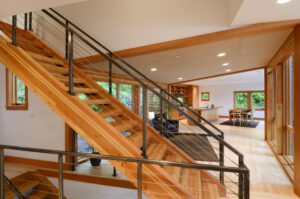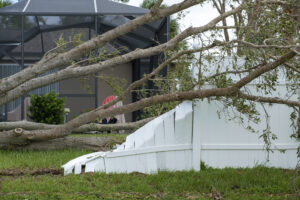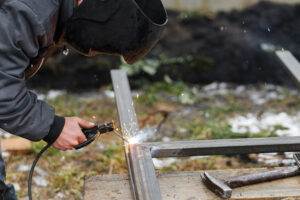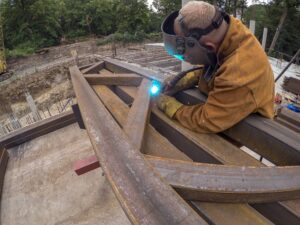Stainless steel cable railing has become a go-to solution for homeowners, architects, designers, and commercial property owners who desire a sleek, modern, and durable system. Whether for a deck, balcony, porch, or stairway, stainless steel cable railings offer safety and an unobstructed view, making them a popular choice in various architectural styles.
At Smith Welding & Fabrication, we have extensive experience designing, fabricating, and installing stainless steel cable railing systems for residential and commercial spaces. Our team is committed to delivering premium-quality solutions that enhance your property’s aesthetics and meet industry standards for safety and durability.
In this guide, we’ll explain everything you need about stainless steel cable railings—from the basics and benefits to design options, installation considerations, and maintenance tips. By the end, you’ll have a comprehensive overview of how they can transform your space and why they’re a worthwhile investment.
What Is a Stainless Steel Cable Railing?
A stainless steel cable railing system is a modern barrier typically used around decks, balconies, porches, interior staircases, and walkways. Instead of traditional wooden or wrought-iron balusters, these railings use horizontal or vertical cables made of corrosion-resistant stainless steel. Depending on the project requirements and design preferences, the posts and framework can also be made from stainless steel, aluminum, or other metals.
Key Components of a Stainless Steel Cable Railing
- Posts/Frames are the vertical or horizontal structural supports anchoring the cables. In some hybrid designs, they can be made from stainless steel, aluminum, or even wood.
- Top Rail: The horizontal bar at the top of the railing system. This can be made of stainless steel, wood, or composite materials.
- Cable: High-tensile stainless steel wire (often 316-grade stainless) that provides the infill for the railing.
- Fittings and Tensioners are small hardware components secure the cable to the posts and allow tension adjustments to ensure the wires remain taut and safe.
Stainless steel cable railings are praised for their minimalist style, longevity, and ability to maintain clear sightlines. If you’re looking for a railing solution that offers both form and function, cable railings are an excellent option.
Benefits of Stainless Steel Cable Railing
There’s a reason stainless steel cable railing has grown in popularity. Below are some of the main advantages you can expect when you choose this type of system:
Unobstructed Views
A cable railing system’s most significant benefit is its nearly transparency appearance. The thin stainless steel cables offer a sleek, low-profile alternative to bulky railing materials, ensuring panoramic views can be enjoyed without obstruction. This is especially beneficial for decks overlooking scenic landscapes, waterfront properties, or rooftop terraces in urban environments.
Modern Aesthetic
Stainless steel cable railings have a contemporary, streamlined look that complements a range of architectural styles. Whether you have a modern high-rise condo, a rustic mountain cabin, or a traditional suburban home with updated features, the cable railing can easily blend in or stand out as a design feature. The metallic sheen of stainless steel adds a touch of sophistication that other railing materials may not provide.
Durability and Longevity
Stainless steel is resistant to corrosion, rust, and extreme weather conditions. A high-quality stainless steel cable railing can last for decades when properly installed and maintained. This makes it a cost-effective choice in the long run, as you won’t need frequent replacements or significant repairs.
Low Maintenance
Unlike wood railings that must be stained, painted, or sealed regularly, stainless steel cable railings require minimal upkeep. Occasionally, you may need to wipe them down or use a mild cleaner to remove dirt and grime. However, the overall maintenance is significantly less compared to other materials.
Safety and Code Compliance
Stainless steel cable railings meet local and national building codes when installed correctly. The tension in the cables ensures they remain strong and secure. Properly spaced cables and sturdy posts help prevent accidents and crovide safety for children and pets,
Eco-Friendly Option
Stainless steel is highly recyclable. If sustainability is part of your project vision, opting for a cable railing system can be a greener choice than materials like exotic hardwood or synthetic composites. Moreover, because stainless steel cable railings have long lifespans, they reduce the environmental impact of frequent replacements.
Popular Stainless Steel Cable Railing Applications
From sweeping outdoor decks to stylish interior staircases, stainless steel cable railing has many applications. Below are some of the most common ways our clients at Smith Welding & Fabrication integrate cable railings into their projects:
- Deck Railing: Homeowners love using cable railings to frame their outdoor decks, which provide a clear view of their backyard, pool area, or scenic vista.
- Balcony Railing: High-rise apartments and condos benefit from the unobtrusive design of cable railings, maximizing the sense of openness.
- Stairway Railing: Interior staircases look stylish and modern with stainless steel cable infill, especially in open-concept floor plans.
- Commercial Spaces: Restaurants, hotels, and office buildings use cable railings for safety and design, creating a modern ambiance that appeals to customers and employees.
- Rooftop Terraces: Cable railings benefit urban environments with rooftop patios by preserving skyline views without compromising safety.
- Pool Enclosures: Cable railings help maintain an open feel around pool areas while meeting safety regulations.
Choosing the Right Materials and Design
When selecting a stainless steel cable railing system, it’s crucial to consider the quality of the materials, the design of the railing, and your budget. Some factors to keep in mind:
Stainless Steel Grade
Not all stainless steel is created equal. Because of its superior corrosion resistanceecommended for outdoor and coastal applications bfor outdoor and coastal applications If installing the railing indoors, you may opt for 304-grade stainless steel, which can be more cost effective but still highly durable. However, f316-grade is the industry standard or maximum resilience and longevity, especially in harsh climates or near saltwater,
Post and Frame Materials
While the cables themselves are typically stainless steel, the framework could be made of different materials:
- All-Stainless Steel: Provides a uniform, contemporary look.
- Aluminum: Lightweight, corrosion-resistant, and can be powder-coated for a customized finish.
- Wood: Combines the warmth of wood with the sleek lines of steel cable, offering a more rustic or transitional style.
- Composite: Engineered materials require minimal maintenance and can mimic the look of wood without upkeep.
Your choice will depend on the overall design of your space, maintenance preferences, and budget considerations.
Cable Arrangement: Horizontal or Vertical
Traditionally, stainless steel cable railing features horizontal cables. However, vertical cables are also an option, providing a unique look and potentially meeting specific code requirements in some jurisdictions. Horizontal cables are more common, but vertical cable railings can offer a striking aesthetic, especially in ultra-modern or commercial settings.
Top Rail Options
The top rail can significantly influence the style of your railing system. Common top rail materials include:
- Stainless Steel: Ideal for a seamless all-metal look.
- Wood (Ipe, Cedar, Mahogany, etc.): Adds a contrasting warm touch to the otherwise sleek metal cables.
- Composite: Durable and low-maintenance, available in various colors.
- Glass Caps: Sometimes used in extremely modern designs, although less common.
When choosing a top rail, consider factors like comfort (if it will be used as a handrail), visual appeal, and ease of maintenance.

Installation Considerations
At Smith Welding & Fabrication, we offer professional installation services to ensure that every stainless steel cable railing meets safety codes and looks impeccable. However, if you’re considering a DIY approach or simply want to understand the key steps involved, here are the main points to keep in mind:
Building Codes and Regulations
Before starting, check your local building codes for regulations regarding cable spacing, post height, and load requirements. In most jurisdictions, the maximum gap between cables is around 4 inches to prevent small children from slipping through.
Proper Tension
Achieving and maintaining the correct cable tension is critical for safety and aesthetics. Cables should remain taut without sagging. Over time, cables stretch slightly and require re-tensioning. Make sure tensioners and fittings are accessible for routine adjustments.
Anchor Points and Structural Support
Each post must be securely anchored to a solid substrate, whether a deck frame, concrete slab, or other sturdy foundation. Using the correct fasteners and ensuring the posts align perfectly will keep the system stable and compliant with safety requirements.
Post Spacing
Typically, posts should be placed no more than 4 to 5 feet apart. This distance helps maintain the correct cable tension without risking bowing or flexing. Your specific project may vary depending on local codes and engineering requirements.
Professional Expertise
While purchasing cable railing kits for DIY projects is possible, partnering with an experienced fabricator or contractor—like Smith Welding & Fabrication—can save you time, money, and potential headaches. Professionals will ensure everything is installed correctly the first time, reducing the risk of costly mistakes and rework.
Maintenance and Care
One of the major perks of stainless steel cable railing is its low-maintenance nature. However, a little care goes a long way in preserving the railing’s appearance and integrity:
- Regular Cleaning: Use a soft cloth or brush with mild soap and water to remove dirt or salt buildup, especially in coastal areas. Rinse thoroughly with water and dry to avoid water spots.
- Inspection: Check cable tension regularly, at least every few months, especially if the railing is in a high-traffic area or exposed to changing weather conditions.
- Polishing: If you prefer a polished look, use a stainless steel cleaner or polish recommended by the manufacturer. This helps to restore shine and protect the metal from fingerprints or minor scratches.
- Avoid Harsh Chemicals: Never use harsh chemicals or abrasive materials that could scratch or damage the stainless steel.
- Re-Tensioning: Cables can stretch slightly over time. Routine tension checks and adjustments ensure the railing remains safe and visually appealing.
With minimal effort, stainless steel cable railings can look as good as new for many years, making them worthwhile investments in residential and commercial settings.
Cost Factors and Budgeting
The cost of installing a stainless steel cable railing can vary widely based on several factors:
- Material Choices: Higher-grade stainless steel (316 vs. 304), exotic hardwood top rails, or premium powder-coated aluminum posts can elevate costs.
- Railing Height and Linear Footage: The more extensive your project, the more materials and labor it will require.
- Complex Design: Staircases, curved railings, and custom angles often complicate the fabrication and installation process, thus increasing costs.
- Labor: DIY vs. professional installation can significantly impact the overall budget. While professional installation may be more expensive initially, it ensures a compliant, high-quality finish with fewer risks of mistakes.
- Location: Projects in remote locations or areas with higher labor costs may also see elevated prices.
At Smith Welding & Fabrication, we provide detailed estimates after evaluating your project’s specific requirements. We’re committed to helping you find a balance between cost-effectiveness and achieving your desired modern aesthetic.
Custom Solutions by Smith Welding & Fabrication
If you’re looking for a specialized or custom stainless steel cable railing design, our Smith Welding & Fabrication team can bring your vision to life. Here’s what sets us apart:
- Expert Consultation: We’ll work closely with you from the initial planning phase to understand your design goals, budget, and functional requirements.
- Quality Craftsmanship: Our skilled welders and fabricators use high-grade materials and precise techniques to ensure each component meets our stringent quality standards.
- Tailored Designs: We can customize everything—from post shapes to top rail materials—to create a unique railing solution that enhances your property’s style.
- Comprehensive Service: Our team offers full-service installation in addition to fabrication. We handle all the details, ensuring code compliance, secure anchoring, and exact cable tension.
- Post-Installation Support: We provide guidance on maintenance and are available for any necessary adjustments or inspections over time.
Whether you’re a homeowner wanting a sleek deck railing or a business owner needing a contemporary statement piece, we have the expertise to deliver on your requirements.
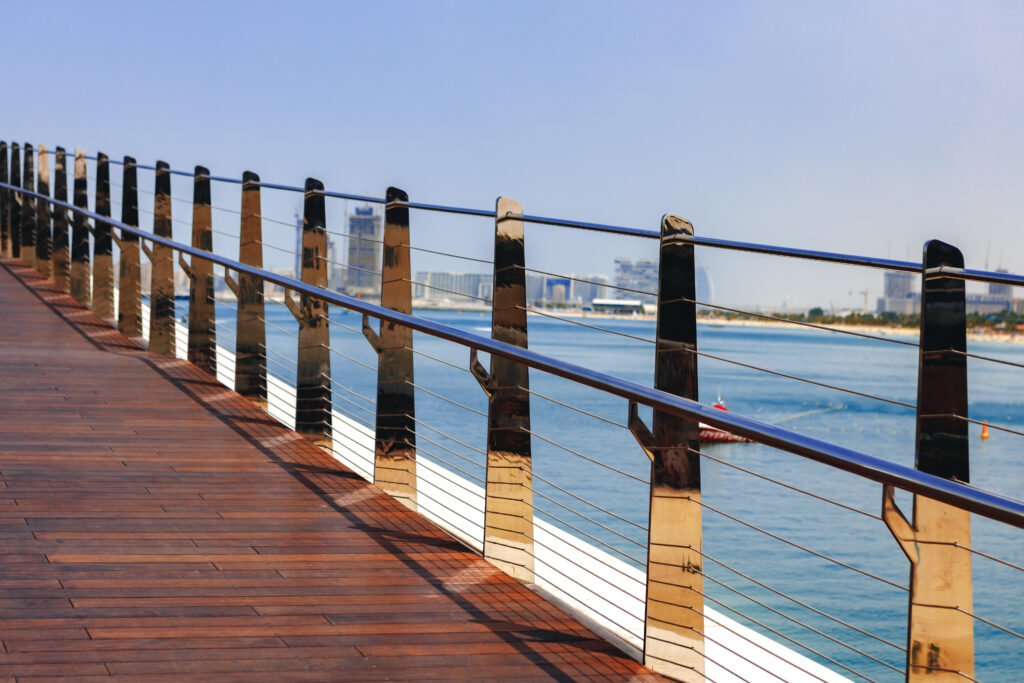
Frequently Asked Questions (FAQs)
Are stainless steel cable railings safe for homes with children or pets?
When correctly installed and maintained, stainless steel cable railings are safe for households with children and pets. The cables must be spaced appropriately (often no more than 4 inches apart) and remain taut to prevent accidents.
Do stainless steel cable railings meet building codes?
In most cases, yes. However, building codes vary by region, so it’s essential to consult local regulations and work with a reputable contractor or fabricator who understands these codes. Many codes require a minimum railing height (usually 36 or 42 inches) and limit cable spacing to 4 inches.
Can I install a cable railing system myself?
While some DIY cable railing kits are available, installing a cable railing system can be complex, especially for large or uniquely shaped areas. Proper tensioning, post-alignment, and anchoring are crucial for safety. We recommend hiring professionals like Smith Welding & Fabrication to ensure compliance with local codes and a flawless finish.
How long does the stainless steel cable railing last?
A stainless steel cable railing can last for decades with high-quality materials and proper care. The durability of stainless steel makes it resistant to rust and corrosion, particularly if you opt for 316-grade stainless steel.
Is stainless steel cable railing more expensive than traditional wood or other railings?
Although the upfront cost can be slightly higher than that of some bare wood or aluminum systems, the long-term value is more economical due to lower maintenance requirements and the material’s longevity. The modern aesthetic can add to your property’s overall appeal and potentially increase its resale value.
What kind of maintenance is required?
Maintenance primarily involves routine cleaning, checking cable tension, and occasionally applying a stainless steel cleaner or polish. More frequent cleaning is recommended in coastal areas to remove salt buildup and prevent corrosion over time.
Transform Your Space with Stainless Steel Cable Railings
Stainless steel cable railings are more than just a railing system—they’re a design statement that can drastically enhance your space’s appearance and functionality. Whether you’re updating an outdoor deck, creating a stunning interior staircase focal point, or renovating a commercial property, a cable railing system provides:
- Open Sightlines
- Contemporary Flair
- Robust Durability
- Low Maintenance
- Versatile Applications
When investing in a railing solution that will stand the test of time while elevating the look of your property, stainless steel cable railing is hard to beat.
Why Choose Smith Welding & Fabrication
At Smith Welding & Fabrication, we aim to deliver superior craftsmanship and exceptional service in every project we undertake. Here’s why clients continually trust us with their stainless steel cable railing needs:
- Decades of Experience: Our team has the hands-on expertise to handle projects of varying sizes and complexities.
- Cutting-Edge Techniques: We stay updated with the latest industry trends, technologies, and best practices to ensure our clients receive top-notch solutions.
- Personalized Approach: From the first consultation, we listen to your goals, style preferences, and budget constraints and tailor our recommendations accordingly.
- Quality Assurance: We source high-grade stainless steel and other premium materials to ensure lasting performance and a flawless finish.
- Customer Satisfaction: Our client-focused approach means we’re there for you every step—from initial design and fabrication to installation and aftercare.
Your property deserves the best. With Smith Welding & Fabrication, you can rest assured that your cable railing project is in capable, reliable hands.
Contact Us for a Free Consultation
Ready to transform your space with a stainless steel cable railing system? Or do you still have some questions before you commit? We’d love to hear from you. Contact Smith Welding & Fabrication today for a no-obligation consultation. Our team is eager to discuss your ideas, provide expert guidance, and offer a detailed estimate that suits your needs and budget.
A stainless steel cable railing system is a wise investment for anyone looking to combine safety, style, and durability. Its modern design, unobstructed views, and minimal maintenance requirements make it a standout choice for decks, balconies, staircases, and commercial applications. By choosing experienced professionals like Smith Welding & Fabrication, you’ll receive a customized and expertly installed system that reflects your unique vision and withstands the test of time.
Whether renovating an existing space or planning a new construction project, we encourage you to consider the benefits of stainless steel cable railings. With proper design, quality materials, and professional installation, your new railing will serve as a functional safety barrier and a striking design feature that complements any architectural style.
Don’t settle for the ordinary. Elevate your space with the clean lines, robust performance, and contemporary flair of stainless steel cable railings. And when you’re ready to start, Smith Welding & Fabrication is here to guide you every step of the way.


